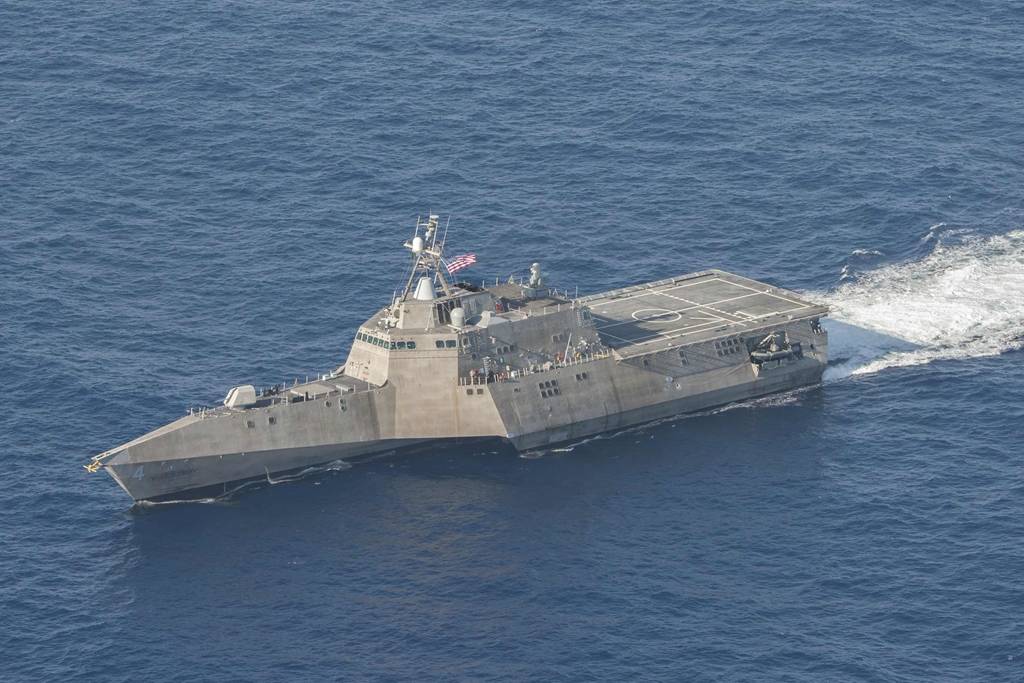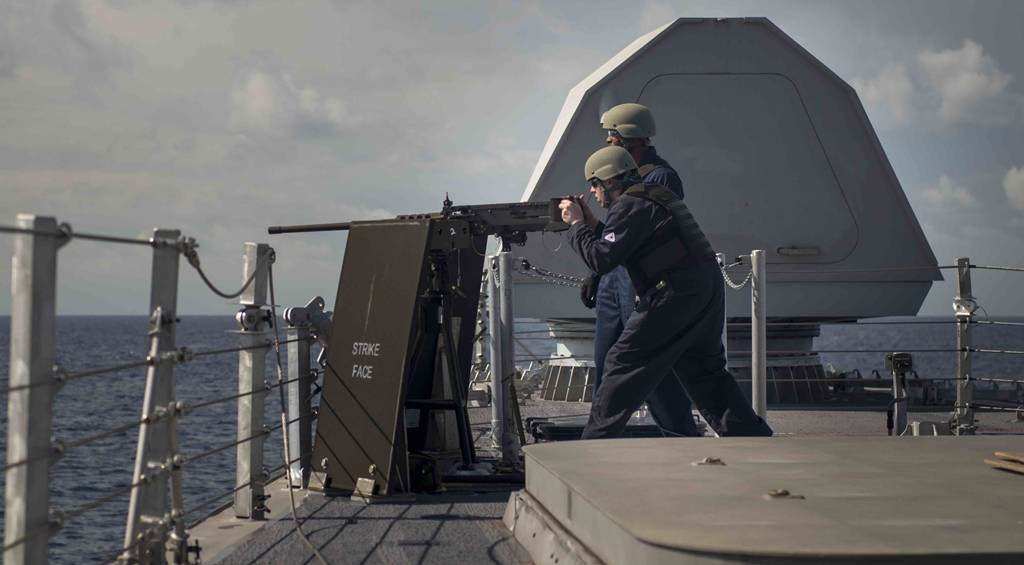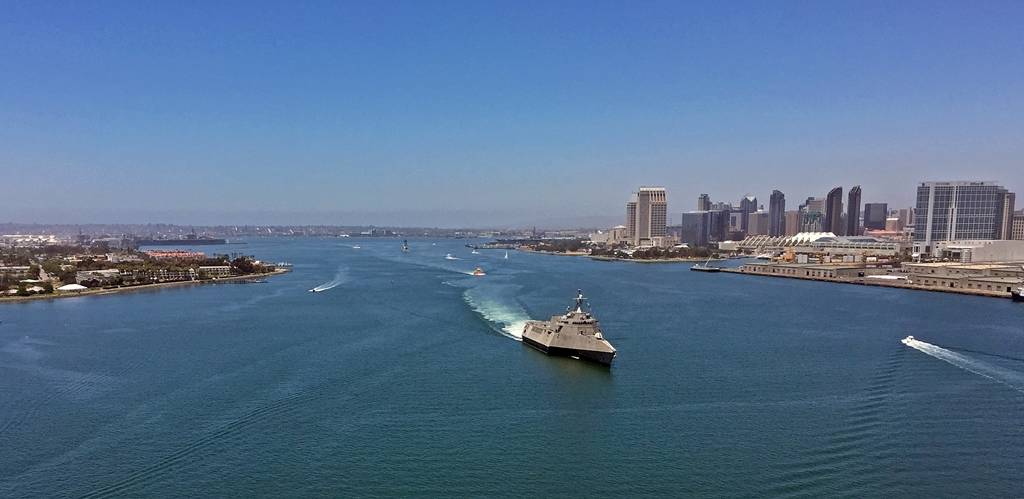
The littoral combat ship USS Coronado (LCS 4) steams through the Pacific Ocean April 23, 2014. The Coronado was underway in the U.S. 3rd Fleet area of responsibility conducting routine operations. (U.S. Navy photo by Chief Mass Communication Specialist Keith DeVinney/Released)
In this article, Scout.com reporter Kris Osborn takes a closer look at the layered defense system on the U.S. Navy’s Independence-variant Littoral Combat Ship USS Coronado (LCS 4).
A Navy Littoral Combat Ship Destroyed an Attacking Swarm of Small Boats
By Kris Osborn, Scout Warrior
A Navy Littoral Combat Ship destroyed an attacking swarm of small boats using a wide range of assets and weapons such as 57mm guns, radar, drones and helicopters, service officials said.
We did a firing against swarming boats using installed 57mm guns in combination with the ships 30mm guns to take out unmanned remote-controlled boats, Capt. Tom Anderson, LCS program manager, told Scout Warrior in an interview.
The swarming small boat attack, which took place off the coast of California, was a key part of an operational test and evaluation of the USS Coronado, or LCS 4.
The test attack was designed to access and demonstrate the LCSs layered defense system which seeks to use a host of assets and integrated technologies as a way to identify and destroy approaching threats, Anderson explained.
During the scenario, at least four armed fast-moving small boats raced after the USS Coronado in an attempt to attack, destroy and overwhelm the ship, he said.
The system of layered defenses, however, worked as intended, Anderson said. Operators on the ship adjust their weapons based upon the range of the threat, he added.
The way it works is you want to have visibility of those swarms coming in as far off as you can. This visibility can come from other ships, helicopters up or the Fire Scout (drone), he said. Longer range assets passes information off to the ship and then the ships radar picks it up as the threat comes in.
The next layers of defense are then a ship-based medium-range missile, followed by 57mm guns and 30mm guns for the closest-in threats.
We worked on taking out those incoming swarms including multiple swarm boats coming at the ship. They were controlled from the beach. We had mannequins on board. When we fired on them and attempted to get to mission kill, we assessed whether we hit the engine, hit the control consul or hit the human being, Anderson added.

Sailors aboard the Independence-class littoral combat ship Pre-Commissioning Unit (PCU) Coronado (LCS 4) fire a .50-caliber machine gun during a crew served weapons qualification. (U.S. Navy photo by Mass Communication Specialist 2nd Class Andrew Johnson/Released)
The medium-range missile used on the LCS is a Hellfire Longbow weapon, a 100-pound guided missile also fired from helicopters. At the same time, Navy program managers are currently exploring the prospect of adding a longer-range over-the-horizon missile to the LCS arsenal as well.
Tactics were also a key factor in destroying the small boat swarms. Anderson added that the 40-knot speed of the LCS gives it a mobility advantage when it comes to thwarting attacks from small boat swarms.
The beautiful thing about LCS is that it is fast enough, so when swarms are coming in you can almost out-pace the small boats. You can get them in a position where you have the longer range weapon, he said.
The 15-foot wake of ocean that trails behind a fast-moving LCS is often itself large enough to swamp small boats before they can ever reach the ship, Anderson added.
Nevertheless, small boat swarms could be a particular threat in shallow, smaller waterways such as straights, water near the shoreline or areas of the ocean described as heavily trafficked choke points.
It is predominantly a littoral threat in areas where there are choke points. Swarms of small boats could be used as one of the tactics instead of having a large surface combatant come out to threaten a ship. They can be lower cost and are very disruptive, Anderson explained.
A large destroyer, by contrast, may be equipped to address a small boat threat but cannot operate in shallower waters and lacks the speed and maneuverability ideally suited to counter small, fast-moving boats, Anderson described.

The littoral combat ship USS Coronado (LCS 4) transits San Diego Bay while returning to Naval Base San Diego. Commissioned in 2014, Coronado is the third U.S. Navy ship to bear the name of the “Crown City” and is the second littoral combat ship of the Independence variant, which features an innovative, trimaran hull. (U.S. Navy photo by Mass Communication Specialist 1st Class Trevor Welsh/Released)
Potential LCS Modifications
The Navy is exploring the prospect of making some modifications to the structure of the LCS in order to accommodate a longer-range missile. Service ship developers are also looking at adding more armor protection onto some of the weapons systems, sensors and magazines.
Improving the electronic warfare capacity of the ship is also a key consideration, along with hardening the combat systems such that they are better able to withstand attacks and remain functional if the ship is hit by enemy fire. This could involve making adjustment to the power and cooling systems aboard the ship, Anderson explained.
Overall, the Navy plans to acquire as many as 32 LCS ships broken down into two variants; an Independence variant with a trimaran hull and a Freedom variant with a flat-bottomed mono-hull. The service plans to have 24 LCS ships delivered by 2019.
The Independence variants are also armed with a ship-defense interceptor missile called SeaRAM, a weapon designed to destroy approaching drones, aircraft, cruise missiles and anti-ship missiles. The defensive weapon is already installed on the Independence variant of the LCS and will be integrated onto the Freedom variant from ship number 17 and forward, Anderson explained.
The LCS ship is engineered in what Navy engineers call a modular fashion, meaning it is designed to more readily and quickly swap out technologies and system and more efficiently integrate new technologies as they emerge, Anderson said.
The ships are configured with so-called mission packages for anti-submarine warfare, surface warfare and countermine operations. The idea is to have swappable groups of integrated technologies able to move on and off the ships as dictated by mission requirements.
The ship can be built at the right pace of construction and the weapons can be developed base on the threat in the real world, Anderson added.
For the swarm boat test, the USS Coronado was configured with the surface warfare package a group of weapons and technologies which includes an MH-60 helicopter, 30mm gun and 11-meter Rigid Inflatable Boats, or RIBs.
In 2016, the USS Coronado is slated to deploy to Singapore.


